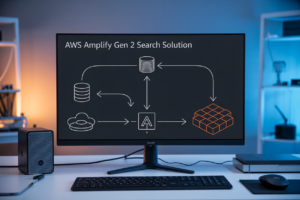Choosing between AWS S3 vs Athena for your big data projects can feel overwhelming when you’re staring at massive datasets and tight deadlines. While both are powerful AWS big data services, they solve different problems – S3 excels at storing and managing your data lake, while Athena shines when you need lightning-fast queries without managing servers.
This guide is for data engineers, analysts, and IT decision-makers who need to make smart choices about big data storage vs analytics tools. You’ll get a clear big data processing comparison that cuts through the marketing fluff and gives you real-world insights.
We’ll break down S3 Athena performance differences so you know which tool handles your workloads better. You’ll also see a detailed S3 Athena cost comparison that helps you budget correctly and avoid surprise bills. Finally, we’ll cover AWS data lake best practices that teams actually use in production, plus specific S3 vs Athena use cases that match your business needs.
Understanding S3 and Athena for Big Data Processing
S3 as a scalable data storage foundation
Amazon S3 serves as the backbone for big data architectures, offering virtually unlimited storage capacity with 99.999999999% durability. Its object-based storage model handles petabytes of structured and unstructured data while providing multiple storage classes for cost optimization. S3’s integration with AWS big data services makes it the preferred data lake foundation, supporting diverse file formats like Parquet, ORC, and JSON. The service’s automatic scaling eliminates capacity planning concerns, while features like versioning, lifecycle policies, and cross-region replication ensure data protection and availability for analytics workloads.
Athena’s serverless query engine capabilities
AWS Athena transforms S3 data into queryable datasets without requiring server management or infrastructure provisioning. This serverless analytics service uses Presto under the hood, enabling SQL queries directly against data stored in S3 with sub-second response times for properly partitioned datasets. Athena supports standard SQL syntax and integrates seamlessly with business intelligence tools like Tableau and QuickSight. Users pay only for queries executed, making it cost-effective for ad-hoc analysis and exploratory data science work. The service automatically handles query optimization, parallel processing, and result caching to maximize Athena query performance.
How both services complement modern data architectures
The AWS S3 vs Athena combination creates a powerful, cost-effective analytics platform that scales from gigabytes to exabytes. S3 provides the foundational data lake where raw data lands from various sources, while Athena enables immediate querying without ETL processes or data movement. This architecture supports both batch and interactive analytics workflows, allowing data engineers to store historical data cheaply in S3 while analysts run on-demand queries through Athena. The serverless nature of both services reduces operational overhead, while their tight integration supports modern data mesh and lakehouse architectures that separate storage from compute for maximum flexibility and cost optimization.
Performance and Speed Comparison
S3 Data Retrieval Speeds and Optimization Techniques
S3 delivers impressive data retrieval speeds when properly configured, with standard storage offering millisecond-level access times for frequently accessed data. The key lies in choosing the right storage class and implementing intelligent tiering. S3 Transfer Acceleration can boost upload speeds by up to 500% by routing traffic through CloudFront edge locations. For maximum performance, use multipart uploads for files larger than 100MB and enable byte-range fetches to retrieve specific portions of objects. Request rate optimization becomes critical when dealing with hot-spotting – distribute your object keys using randomized prefixes to avoid throttling. S3 Select provides a game-changer for big data scenarios, allowing you to retrieve only the data you need rather than entire objects, reducing transfer costs and improving speed by up to 400%.
Athena Query Performance for Interactive Analytics
Athena excels at interactive analytics with query response times typically ranging from seconds to minutes, depending on data size and complexity. The service automatically scales to handle concurrent queries without provisioning servers, making it perfect for ad-hoc analysis. Query performance heavily depends on data format and partitioning strategy – columnar formats like Parquet can deliver 5-10x faster query times compared to CSV or JSON. Athena’s serverless architecture means you’re not limited by fixed compute resources, and the service can process petabytes of data efficiently. Compression plays a huge role in performance – GZIP compression can reduce data scan volumes by 70-90%, directly translating to faster queries and lower costs. The MSCK REPAIR TABLE command helps maintain optimal partition discovery for consistently fast query execution.
Latency Differences in Real-World Scenarios
Real-world latency patterns show distinct differences between S3 and Athena performance characteristics. S3 provides sub-100ms latency for simple object retrieval operations, making it ideal for applications requiring immediate data access. Athena queries typically show higher initial latency (2-10 seconds) due to query planning and resource allocation, but this overhead becomes negligible for complex analytical workloads. Cold starts in Athena can add 5-15 seconds to query execution, while S3 maintains consistent response times regardless of access patterns. Network proximity plays a crucial role – keeping your compute resources in the same AWS region as your data reduces latency by 50-80ms per request. For time-sensitive applications, S3’s predictable latency makes it the clear winner, while Athena’s variable latency is acceptable for analytical workloads where thoroughness matters more than speed.
Throughput Capabilities for Large-Scale Operations
Throughput performance scales dramatically between these services based on workload patterns. S3 can handle virtually unlimited concurrent requests with aggregate throughput reaching multiple terabytes per second across all your applications. Single-object downloads max out at around 5.5 Gbps, but parallel downloads can multiply this significantly. Athena query throughput depends on data complexity and concurrent user count, typically processing 1-100 GB per second per query depending on the operation. For bulk data operations, S3 Batch Operations can process billions of objects efficiently, while Athena handles complex aggregations across petabyte-scale datasets. Multi-region replication in S3 enables global throughput distribution, whereas Athena’s throughput is region-specific but can be parallelized across multiple regions for global analytics workloads. The sweet spot for Athena lies in complex analytical queries where its distributed processing architecture shines.
Cost Analysis and Pricing Models
S3 Storage Costs Across Different Tiers
S3 offers multiple storage classes optimized for different access patterns and cost requirements. Standard storage costs approximately $0.023 per GB monthly, while Intelligent-Tiering automatically moves data between access tiers for $0.0125 per 1,000 objects monitored. Infrequent Access (IA) reduces costs to $0.0125 per GB but charges retrieval fees. Glacier storage drops to $0.004 per GB for long-term archival, though retrieval times range from minutes to hours. Deep Archive provides the lowest cost at $0.00099 per GB but requires 12-hour retrieval windows. Smart organizations leverage lifecycle policies to automatically transition data between tiers based on access patterns, dramatically reducing storage expenses for big data workloads.
Athena’s Pay-Per-Query Pricing Structure
Athena charges $5 per terabyte of data scanned during query execution, making it incredibly cost-effective for sporadic analytics workloads. Unlike traditional data warehouses requiring constant compute resources, you only pay when running queries. A typical query scanning 100 GB costs just $0.50, while complex analytical queries processing multiple terabytes might cost $10-50. The pricing model rewards efficient query design and data organization since compressed, partitioned, and columnar formats like Parquet dramatically reduce scan volumes. Organizations running hundreds of queries daily often see monthly Athena bills under $500, compared to thousands for dedicated analytics infrastructure.
Hidden Costs and Budget Optimization Strategies
Beyond base pricing, several hidden costs can impact your AWS S3 Athena cost comparison budget. S3 requests fees accumulate quickly with frequent PUT/GET operations, while cross-region data transfer charges $0.09 per GB. Athena queries against poorly partitioned data scan unnecessary files, inflating costs exponentially. Data format choices significantly impact expenses – converting JSON to Parquet typically reduces query costs by 80-90%. Implement S3 lifecycle policies, use compression algorithms like GZIP, and partition data by commonly queried fields. CloudWatch monitoring helps identify expensive query patterns, while S3 Inventory reports reveal optimization opportunities across your big data storage infrastructure.
Optimal Use Cases for Each Service
When S3 excels as your primary data solution
Amazon S3 shines as your go-to platform when you need massive-scale data storage with infrequent query requirements. Companies handling petabytes of raw data – think IoT sensor readings, log files, or backup archives – find S3’s virtually unlimited storage capacity and rock-bottom pricing unbeatable. S3 works best for data lakes where you’re primarily storing structured and unstructured data for future processing, content distribution networks serving static assets globally, or compliance scenarios requiring long-term data retention. The service excels when your workload involves batch processing, ETL operations, or serving as a central repository feeding multiple downstream analytics tools.
Athena’s sweet spot for ad-hoc analytics
Athena dominates when business users need quick answers from stored data without managing complex infrastructure. This serverless query service perfectly handles exploratory data analysis, business intelligence dashboards, and one-off investigations where spinning up dedicated clusters would be overkill. Data analysts love Athena for its ability to query CSV, JSON, and Parquet files directly in S3 using familiar SQL syntax. The service shines brightest with semi-structured data analysis, interactive reporting scenarios, and situations where query patterns are unpredictable. Teams conducting data discovery, building proof-of-concepts, or running periodic reports find Athena’s pay-per-query model both cost-effective and operationally simple.
Hybrid approaches that maximize both platforms
Smart organizations combine S3 and Athena to create powerful data architectures that leverage each service’s strengths. The most effective pattern stores raw data in S3 while using Athena for querying and analysis, creating a seamless data lake analytics solution. Companies often implement tiered storage strategies – keeping frequently accessed data in S3 Standard for Athena queries while archiving older data to Glacier for cost savings. Another winning approach involves using S3 as the central data repository while Athena handles business user queries, with additional tools like EMR or Glue processing heavy transformations. This hybrid model delivers the AWS big data services flexibility businesses need while optimizing both performance and costs.
Industry-specific implementation scenarios
Financial services companies typically use S3 for regulatory compliance storage while Athena analyzes trading patterns and risk metrics from historical data. Healthcare organizations store patient records and imaging data in S3’s secure environment, then use Athena for population health analytics and clinical research queries. E-commerce platforms leverage S3 for customer behavior data and product catalogs, with Athena powering real-time inventory analysis and personalization engines. Media companies store video content and metadata in S3 while using Athena to analyze viewer engagement patterns and content performance metrics. Manufacturing firms collect IoT sensor data in S3 and query it through Athena for predictive maintenance and quality control insights.
Best Practices for Implementation
S3 Bucket Organization and Partitioning Strategies
Structure your S3 buckets using logical hierarchies that mirror your query patterns. Create partitions based on frequently filtered columns like date, region, or category using formats like year=2024/month=01/day=15/. This partitioning strategy dramatically reduces Athena scan costs and improves query performance by limiting data processing to relevant subsets.
Athena Query Optimization Techniques
Write selective WHERE clauses that leverage your partition keys to minimize data scanning. Use LIMIT clauses for exploratory queries and avoid SELECT * statements in production workloads. Compress and convert data to columnar formats like Parquet before querying. Create external tables with proper data types to prevent unnecessary type conversions during query execution.
Data Format Selection for Maximum Efficiency
Choose Parquet or ORC formats for analytical workloads as they provide superior compression ratios and query performance compared to CSV or JSON. Parquet works exceptionally well with AWS big data services and reduces both storage costs and Athena processing time. Convert existing data using AWS Glue ETL jobs or EMR clusters for optimal results.
Security and Access Control Configurations
Implement bucket policies and IAM roles that follow the principle of least privilege. Enable S3 server-side encryption and configure Athena workgroups with query result encryption. Use AWS CloudTrail to monitor access patterns and set up VPC endpoints for secure data transfer. Apply fine-grained permissions using AWS Lake Formation for enterprise data governance requirements.
Monitoring and Performance Tuning Methods
Set up CloudWatch metrics to track query execution times, data scanned per query, and cost per workload. Use Athena query history to identify expensive queries and optimize them. Monitor S3 request patterns and implement appropriate storage classes for frequently and infrequently accessed data. Enable AWS X-Ray tracing for complex data pipelines to identify bottlenecks.
Amazon S3 and Athena each bring distinct advantages to your big data strategy. S3 excels as a cost-effective storage solution for massive datasets, while Athena shines when you need quick, serverless analytics without managing infrastructure. The performance gap between them depends entirely on your specific use case – S3 works best for data archiving and batch processing, while Athena handles ad-hoc queries and interactive analytics beautifully.
The smart move isn’t choosing one over the other, but understanding how they complement each other. Store your data in S3 for durability and cost savings, then leverage Athena when you need to query that data quickly. Start with your current data volume, query frequency, and team expertise to determine the right mix. Test both services with your actual workloads before committing to a long-term architecture – this hands-on approach will reveal which combination delivers the best performance and value for your organization.




















